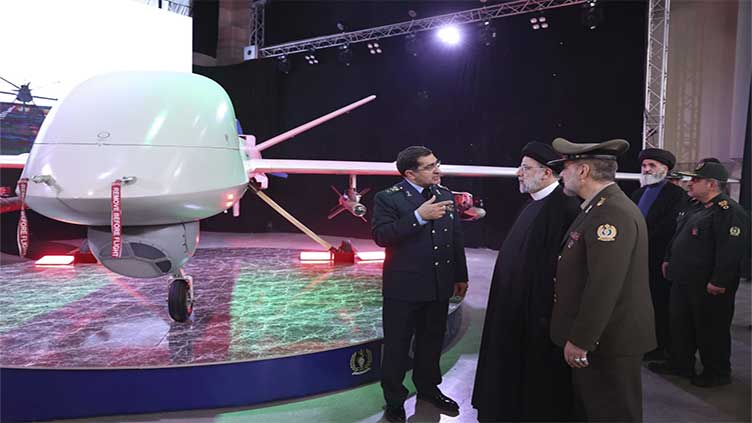Iran’s Defense Ministry unveiled a drone on Tuesday resembling America’s armed MQ-9 Reaper, claiming that the aircraft is capable of staying airborne for 24 hours and has the range to reach the country’s archenemy Israel.
Iran’s state-run IRNA news agency published a photograph of the drone, called the Mohajer-10, on display at a conference marking Defense Industry Day with what appeared to be smoke-machine fog underneath it.
“Mohajer” means “immigrant” in Farsi and has been a drone line manufactured by the Islamic Republic since 1985.
IRNA said the drone is able to fly up to 24,000 feet with a speed of 210 kph (130 mph), carrying a bomb payload of up to 300 kilograms (660 pounds). It also said the drone could carry electronic surveillance equipment and a camera. Iran’s hard-line President Ebrahim Raisi, a protégé of Supreme Leader Ayatollah Ali Khamenei, also viewed the drone on Tuesday.
Iran’s foreign minister visits Saudi Arabia’s powerful crown prince as tensions between rivals ease
“Today, we can firmly introduce Iran as an advanced and technologic nation to the world,” Raisi said in comments aired on state television.
He reiterated Iran’s stance about friendly relations with “all countries in the world,” adding that Iran’s armed forces will cut off any hand that will reaches out in an attempt to invade Iran, state TV reported.
The Associated Press could not immediately verify the claims about the drone’s capabilities, though an arm of state television shared a video of it taking off from a runway. Long-range drones like the Reaper also require ground stations and satellite communications.
Officials in Israel, which flies its own long-range, high endurance drones, did not immediately respond to a request for comment Tuesday.
Iran has in the past captured U.S. drones or pieces of them, but there’s no evidence that it has taken a General Atomics’ Reaper, which is flown by the U.S. Air Force and allied American nations as a “hunter-killer” drone that can operate at high altitudes for long hours and follow a target before attacking. North Korea in July showed off drones mirroring the Reaper, possibly designed from publicly available information about the aircraft.
In December 2011, Iran seized an RQ-170 Sentinel flown by the CIA to monitor Iranian nuclear sites after it entered Iranian airspace from neighboring Afghanistan. Iran later reverse-engineered the drone to create their own variants.
In 2019, Iran shot down a U.S. Navy RQ-4A Global Hawk in the Strait of Hormuz amid high tensions over its collapsed nuclear deal with world powers.
The Reaper also carries special significance for Iran, as one reportedly carried out the 2020 strike in Baghdad that killed Qassem Soleimani, a top Iranian general in its paramilitary Revolutionary Guard.
Iran separately said it had provided two types of ballistic missiles to its army and the Guard on Tuesday, including one named for Soleimani.
Iran has unveiled a series of drones it describes as capable of long-endurance flights over the last several years. It remains unclear how they’ve been used in combat.
But other Iranian drones have been a key element of Russia’s continued war on Ukraine. Tehran has offered a series of contradictory explanations about the drones, first denying they supplied them to Moscow and then claiming they sold drones only before the war began. However, the volume of drones used in the conflict show a steady supply by Iran of the bomb-carrying weapons in the war.
In June, the White House said Iran is providing Russia with materials to build a drone manufacturing plant east of Moscow as the Kremlin looks to lock in a steady supply of weaponry.
Post Views: 59


 Sports3 months ago
Sports3 months ago
 Fashion3 months ago
Fashion3 months ago
 Sports3 months ago
Sports3 months ago
 pakistan3 months ago
pakistan3 months ago
 pakistan3 months ago
pakistan3 months ago
 World3 months ago
World3 months ago
 World3 months ago
World3 months ago
 Sports2 months ago
Sports2 months ago




















